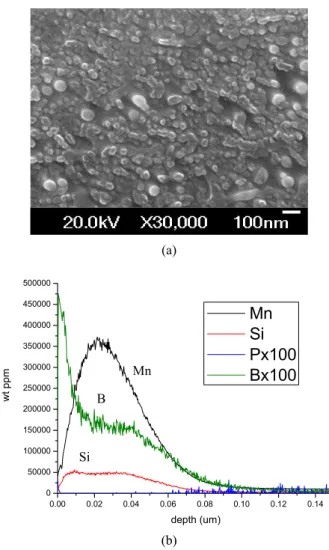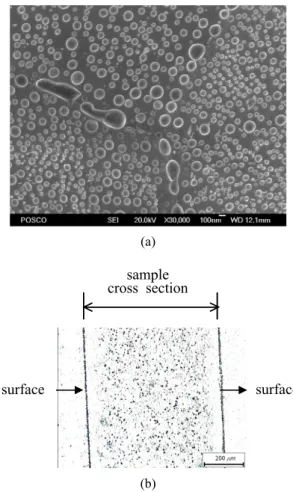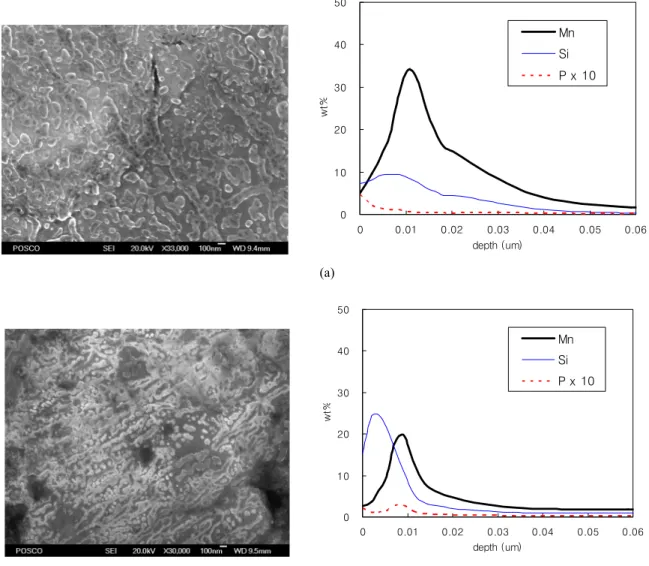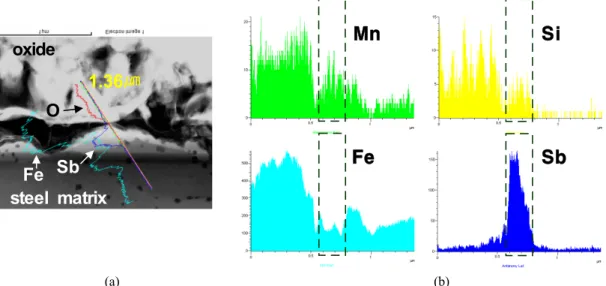Surface Oxidation of High Strength Automotive Steels during Continuous Annealing, and the Influence of Trace Elements of
P,B, and Sb
Il-Ryoung SOHN†, Joong-Chul PARK, and Jong-Sang KIM
Technical Research Lab., POSCO, 699, Gumho-dong, Gwangyang-si, Jeonnam, 545-090, Korea (Received October 1, 2009; Revised December 29, 2010; Accepted December 29, 2010)
In continuous hot dip galvanizing process, oxide formation on steel surface has an influence on Zn wetting.
High strength automotive steel contains high amount of Si and Mn, where Si-Mn composite oxides such as Mn2SiO4 or MnSiO3 covers the surface after annealing. Zn wetting depends on how the aluminothermia reaction can reduce the Mn-Si composite oxides and then form inhibition layer such as Fe2Al5 on the steel surface. The outward diffusion of metallic ions such as Mn2+, Si2+ in the steel matrix is very important factor for the formation of the surface oxides on the steel surface. The surface state and grain boundaries provide an important role for the diffusion and the surface oxide reactions. Some elements such as P, Sb, and B have a strong affinity for the interface precipitation, and it influence the diffusivity of metallic ions on grain boundaries. B oxide forms very rapildly on the steel surface during the annealing, and this promote complex oxides with SiO2 or MnO. P has inter-reacted with other elements on the grain boundaries and influence the diffusion through on them. Small addition of Sb could suppress the decarburization from steel surface and retards the formation of internal and external selective oxides on the steel surface. Interface control by the trace elements such as Sb could be available to improve the Zn wettability during the hot dip galvanizing.
Keywords : oxidation, high strength automotive steel, annealing, Zn wettability
†Corresponding author: irsohn@posco.com
1. Introduction
Automotive outer panels require very strict surface qual- ity and good Zn wettability. Incorporation of alloying ele- ments such as Mn, Si, Al, B, etc raises the mechanical strength of automotive steel. Higher amount of such ele- ments would be used in automotive steel sheets by the strong request of autobody weight reduction. However, most of these elements have higher oxygen affinity than Fe and cause a selective oxidation during the manufactur- ing processes of steel sheets.
Oxides on steel surface lower the surface quality by influencing its morphology and Zn wettability. Recently many research efforts are focused to study on oxidation behavior,1)~3) oxide structures4),5) and oxide formation by trace elements.6),7) However, the oxidation phenomena on steel surface are not well understood due to their complex interactions among chemical elements and various process variables.
Generally, some trace elements i.e. P, Sn, Sb etc are incorporated into the steel matrix, where some of them are easily precipitated at the interface between grains and metal surface. These elements could severely affect short- cut diffusion through interface and this behavior could be used to control the oxidation of steel surface. Boron, B is a very effective element for hardening steel and oxide readily forms on steel surface even with a small amount.
Boron oxide has a low melting point, which causes it to readily form complex composite oxides with SiO2 and/or MnO and to decrease Zn wetting.2),6) Reciprocal reaction of alloy elements is also considered to understand the oxi- dation behaviors on the steel sheets.
In this study, oxidation behaviors of trace elements are like B, P, and Sb on steel surface is studied in an annealing furnace. The formation of boron oxides and depletion of boron on steel surface have been observed. The influence of P and Sb on the formation of surface oxide has been also examined, which is followed by discussion of the im- pact of Si and Mn to form complex oxides.
2. Experimental
The study examined commercially available high strength Intersticial Free(IF) steels and TRansformation-Induced Plasticity(TRIP) and Dual Phase(DP) steels. A variety of alloy elements in broad range of compositions were in- cluded in test samples. Main elements included 0.1~1.0 wt% of Si, 0.4~2.1 wt% of Mn, and 0~1 wt% of Sb. Ingots were melted in a vacuum furnace and cast into 170 x 230
x 60 t(mm) steel molds. The surface of cast was ground to remove surface defects during the process. It was heated up to 1250 ℃ and maintained for 1 hour, followed by hot rolling in 9 passes at 910~930 ℃ to 3 mm thickness.
Then, the sheets were put into a furnace at 550~680 ℃ for 1 hour followed by cooling in the furnace. The hot strips were pickled in HCl solutions for removing scale and it was subsequently cold rolled to 1 mm thickness.
The panels, measuring 120 x 200 mm, were cut from the cold rolled sheet for annealing test. The oxidation of sam- ples during the annealing process was tested in a labo- ratory hot-dip simulator. Atmosphere of the heating cham- ber was mixed gas of N2-H2 where H2 was contained with 5~15 vol%. Dew point in the heating chamber was con- trolled to maintain at around -40 ~ -60 ℃. Fig. 1 shows the heat cycle of continuous annealing in this study. The oxide morphology on steel surface was analyzed using FE-SEM and FE-TEM. Specimens were prepared by fo- cused ion beam (FIB) for observing cross sections of oxide
Fig. 1. Schematic of heat cycle for continuous annealing.
Fig. 2. Schematic of particle tracking autoradiography (PTA) technique.
scale. Glow discharge optical emission spectrometry (GDOES) was used to observe elements profile on the specimen surface. Particle tracking autoradiography (PTA) technique was used to investigate boron distribution on the surface after annealing as show in Fig. 2 A film type of solid state nuclear detector was attached on a polished sample surface and then neutron ray was irradiated on the sample. Boron or its compounds were reacted with neutron and Li, α- particle was generated, which was detected by a detector.
3. Results and discussions
Small amount of B is enough to increase hardness of high strength steels. Fig. 3 shows the surface morphology and GDOES element profiles on the 1.9%Mn-0.1%Si- 0.0007%B (mass %) DP steel which was oxidized in N2-5%H2 with a dew point of -50 ℃ at 800 ℃. Tiny ox-
(a)
0.00 0.02 0.04 0.06 0.08 0.10 0.12 0.14
0 50000 100000 150000 200000 250000 300000 350000 400000 450000 500000
wt ppm
depth (um)
Mn Si Px100 Bx100
Mn B
Si
(b)
Fig. 3. Oxide formation on the 1.9%Mn-0.1%Si-0.0007%B steel sheet after annealing in N2-5%H2 with a dew point of -50 ℃ at 800 ℃. (a) oxide morphology by FE-SEM, (b) GDOES element profile of Mn, Si, P and B.
ides are formed on the surface and mainly it consists of Si, Mn and B oxides. The oxide ratio on the surface could be estimated by using GDOES element profiles and den- sity of the B2O3, SiO2, and MnO. It is estimated that 1.5 wt% B2O3 is contained on the surface based on Fig. 3 This suggests that oxidation of B is very fast compared with other elements in steel matrix, considering only 7 ppm of B is contained in the matrix. The thickness of B2O3 is estimated to be about 100nm and 50 ㎛ thick boron should be consumed to make 1.5 wt%B2O3 in oxide scale during the annealing process.
Fig. 4(a) shows surface oxide morphology on the 0.6%Si-0.9%Mn-0.08%P-0.0005%B IF steel sheets after annealing in N2-5%H2 with a dew point of -40 ℃ at 800
℃. After annealing, the cross section of the sample was polished and a neutron diffraction pattern of B was ac- quired by PTA technique. Dark spots are concentrated on surface and B is depleted about 50 ㎛ from the surface.
This suggests that most B near metal surface is consumed for oxidation during annealing process.
Melting point of B2O3 is around 450 ℃, which is rela- tively lower than other oxides on the surface including MnO or SiO2. The melting point of Mn-Si-B composite oxides would decrease along with the increasing amount of B2O3. B2O3 is concentrated at the top of composite ox- ide as shown in Fig. 4(b) and this suggests that melting point of top surface for Mn-Si-B oxides could decrease more during the annealing process. Circular oxides are formed on the surface as shown in Fig. 4(a). There are several possibilities to make such circular oxides during the annealing. One of them is partial melting of oxides during the annealing process because of the B2O3 in the oxides. It is also considered that most of the B2O3 con- tained Si-Mn oxides are amorphous which leads to random growth. However, the reason circular oxide formation in B added steels is not clear yet.
The boron oxide formation on metal surface is very im- portant for the surface quality of galvanized steels since Zn wetting gets worse by the increasing amount of boron oxide.8) Further study is required for fully understanding the chemical and mechanical properties of composite oxide which contains boron oxide and thermo-chemical reaction of oxide layer during continuous galvanizing process.
Fig. 5 shows oxide morpholoy and GDOES element profile on the 0.1C-1Si-1.5Mn-0.08P (High P; Mn/Si ratio
= 1.5) and 0.14C-1Si-2.1Mn-0.01P (Low P; Mn/Si ratio
=2.1) steels after annealing in N2-15%H2 with a dew point of -60 ℃ at 800 ℃ for 86 sec. The Si content is similar in both steels while Mn is less in High P steel. However, the ratio of Mn oxides is higher on the High P steel than on the Low P steel. This is reverse tendency of the steel
(a) sample cross section
surface surface
(b)
Fig. 4. Oxide formation on the 0.6%Si-0.9%Mn-0.08%P- 0.0005%B steel sheet after annealing in N2-5%H2 with a dew point of -40 ℃ at 800 ℃. (a) oxide morphology by FE-SEM, (b) B diffraction pattern of a cross section by PTA.
compositions. Nodular type oxides are formed in High P steel and they are mainly manganese oxide as shown in the GOEDS profile data. Plate type SiO2 oxides are formed on Low P steel even with higher Mn content. Most P ap- pears at the shallow top of High P steel. For Low P steel, some of P are concentrated at the top and some other parts are concentrated in the Si and Mn oxides. It is considered that high diffusion coefficient of P in ferrite leads to co-segregation with Manganese oxides on the steel sur- face2) and this promotes the growth of nodular type MnO oxides at grain boundaries of High P steel. It has been known that the oxidation behavior of steel containing Mn and P depends on dew point of annealing atmosphere.2),9) It seems that the oxide formation depends on other ele- ments such as C, Cr, Si etc. and the oxidation conditions as well. Swaminathan et al studied for the high strength 1.8Mn-0.43Si steel and it shows that when the dew point increases from -29 ℃ to 0 ℃ the surface oxide composi- tion transforms from Si-Mn composite oxides to the Mn3(PO4)2 and internal oxidation of Cr which promote
0 10 20 30 40 50
0 0.01 0.02 0.03 0.04 0.05 0.06
depth (um)
wt%
Mn Si P x 10
(a)
0 10 20 30 40 50
0 0.01 0.02 0.03 0.04 0.05 0.06
depth (um)
wt%
Mn Si P x 10
(b)
Fig. 5. Oxide morphologies and GOEDS profile of the steel sheet after annealing in N2-15%H2 with a dew point of -60 ℃ at 800 ℃ for 86sec. (a) 0.1C-1Si-1.5Mn-0.08P (High P), (b) 0.14C-1Si-2.1Mn-0.01P (Low P).
the Zn wettability.2) On the contrary, Hertveldt et al studied for P- and Mn-added TiNb IF steel with dew points of - 30 ℃ and +10 ℃.9) The surface was covered with small globular oxides about 0.3 ㎛ formed on the grain surfaces and this mainly consist of Mn oxides at a dew point of -30 ℃. When annealing at higher dew point of +10 ℃, a smaller quantity of external oxides are formed on grain surfaces and Mn-P-O compounds are formed internally and this leads good Zn wettability.9)
The other reason is that the P segregates in the grain boundaries and it has reciprocal reaction with other ele- ments on the grain boundaries. The P has site competition with other elements such as C, Si, S etc in the grain boundaries. Si and P have repulsive interaction on the grain boundaries.10) P in the grain boundaries could repulse the Si on the grain boundaries and this suppresses the short
cut diffusion of Si through the grain boundaries. It is con- sidered that P promote the rough Mn-P composite oxide and suppress the formation of SiO2 on the steel surface as shown in Fig. 5
Sb has been noticed its oxidation control properties of the high strength steel during the annealing.6),7) Fig. 6 shows the oxide morphologies on the 0.005C-0.35Cr- 0.4Mn (Sb free steel) and 0.005C-0.35Cr-0.4Mn-0.05Sb (Sb steel) steels. Oxides are formed larger and some of oxides are connected each other on the Sb free steel. With the increase of the Sb, oxide growth decreased and the morphologies become finer and more homogeneous.6) Several reasons have been suggested about the suppression of oxidation on the Sb added steels. It is considered that Sb is segregated on the steel surface during the oxidation and this suppress the outward diffusion of metal cations,
(a) (b)
Fig. 6. Oxide morphologies on the 0.005%C-0.35%Si-0.4%Mn steels with and without Sb after annealing in N2-10%H2 with a dew point of -40 ℃ at 800 ℃. (a) Sb free steel, (b) 0.1% Sb added steel.
Si oxide Mn
1.36㎛
O
Fe Sb Fe steel matrix
Sb
(a) (b)
Fig. 7. A cross section of hot rolled 0.005%C-0.35%Si-0.4%Mn-1%Sb and Nano Beam EDS analysis about scale-metal interface for Mn, Si, Fe and Sb. (a) A cross section of scale-metal interface by SEM, (b) EDS intensity analysis.
otherwise, Sb might be present steel surface as a noble metal layer which suppress oxygen permeability on the steel surface.6),7) However, Sb addition in the steel is very low levels and it is difficult to observe the presence of Sb at the interface.
To observe the Sb at the oxide-steel interface, 1% Sb added hot strip steel is examined as shown in Fig. 7. About 10 ㎛ thickness scales remained on the steel strip surface after the hot rolling. Sb is concentrated between the oxide scale and the steel matrix as isolated form and the thick- ness is about 200 nm as shown in Fig. 7 (b). It also con- tains small amount of Si and Mn. The shape of the Sb concentrated area is irregular and it’s maximum thickness is not over 250 nm. Sb concentrated form is not observed
in the Fe oxides on the steel strips. Sb in the steel matrix could form as intermetallic phases such as ε-FeSb or FeSb2.11) The Sb in the steel surface could decrease the oxide growth on the steel surface because this Sb rich area could block the diffusion of metallic cations from the steel matrix. Some internal oxides are observed in the Sb concentrated area and steel matrix near the surface.
Small spots in the steel matrix is analyzed as SiO2 main oxides as shown in Fig. 7.
4. Conclusions
Si- Mn- compound oxides mainly formed on the high strength steels after the annealing and these oxides could
strongly decrease the Zn wettability as a reaction barrier on the steel surface. B, P and Sb are minor elements or sometimes they are treated as tramp elements. However, it could conspicuously influence the oxide formation on the steel sometimes as an oxide former or as a contributor for the oxidation. B in the steel surface could be quickly consumed during the annealing by the formation of surface oxides. Usually B in the steel matrix is limited as several ppm, however, Boron oxides could be formed up to several percent in the surface oxide. As the rapid consumption of B during the annealing, B depleted zone is observed up to 50 ㎛ from the steel surface. P could be formed as a part of surface oxides especially co-segregated with Mn oxides. P is also segregated in grain boundaries and this impedes the formation of SiO2 oxides on the steel surface. Sb is concentrated in the oxide/steel interface as a metallic phase. Sb concentrated layer in the metal surface could retard the oxide growth on the steel surface. Oxida- tion in the annealing furnace is also considered the mutual reaction of trace elements in the steel. Interface behaviors of the trace elements in the steel needs further study to control the surface reaction on the steel sheets.
References
1. Y. Suzuki, T. Yamashita, Y. Sugimoto, S. Fujita, and S. Yamaguchi, ISIJ Int., 49, 564 (2009).
2. S. Swaminathan T. Koll, M. Pohl, and M. Spiegel, Proc.
Galvatech ’07, 460 (2007).
3. I. Cvijovic I. Parezanovic, and M. Spiegel, Corros. Sci., 48, 980 (2006).
4. Y.F. Gong, H.S. Kim, and B.C. de Cooman, ISIJ Int., 49, 557 (2009).
5. X.S. L, S.I. Baek, C.S. Oh, S.J. Kim, and Y.W. Kim, Script Mater., 57, 113 (2007).
6. I.R. Sohn, S.H. Jeon, H.J. Kang, and K.G. Ghin, Proc.
Galvatech ’07, 439 (2007).
7. Z. Zhang, I.R. Sohn, F.S. Pettit, G.H. Meier, and S.
Sridhar, Metall. Mater. Trans. B., 40, 550 (2009).
8. X. V. Eynde, L. Bordignon, and M. Lamberigts, Proc.
Galvatech ’04, 373 (2004).
9. I. Hertveldt, B.C. de Cooman, and S. Claessens, Metall.
Mater. Trans. A, 31A, 1225 (2000).
10. P. Lejeck, A.V. Krajnikov, Yu.N. Ivashchenko, and M.
Militzer, J. Adamek, Surf. Sci., 280, 325 (1993).
11. D. Boa, S. Hassam, J. Rogez, and K.P. Kotchi, J. Alloys.
compd., 365, 228 (2004).



